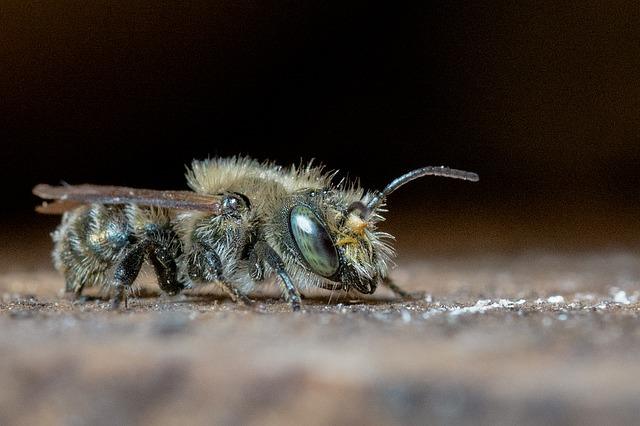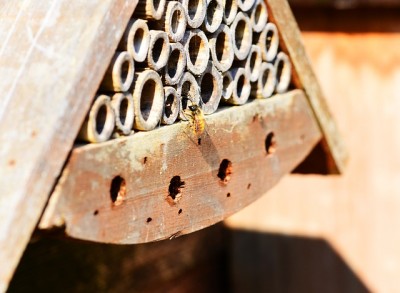When you think of attracting a super-pollinating machine to your backyard garden, you probably don’t instantly think of the mason bee. Most people think of the honeybee instead. But there is good reason for making your property attractive to the mason bee.
For starters, they are much better pollinators than the honeybee. For example, an orchard can be pollinated by only 250 mason bees – compared to needing 50,000 honeybees. And, because mason bees have a limited range of only about 300 feet, they are ideal for backyard gardens.
Mason bees, in fact, are about 200 times more efficient in pollinating than honeybees.
So, What Is a Mason Bee?
The mason bee is a solitary bee that is slightly smaller than the honeybee, and it commonly has a blue-black sheen that can make it mistakable for a housefly. There are 140 species of this insect which are native to North America, as well as about 70 species native to Europe and Asia.
The Ultimate Guide to Keeping Stronger Colonies and Healthier, More Productive Bees
Also called orchard bees, mud bees or twig bees, these insects do not build their own nests but rather search out narrow tunnels left behind by wood boring insects in the bark of trees or hollow stems in which they can lay their eggs. They then seal the eggs inside the hole with mud. They also can live in homemade mason bee houses (which will be discussed in a moment).
Although they do not live in colonies like honeybees do, mason bees do like to make their nests in clusters. And while they do have the ability to sting like any other bee, the absence of a queen to protect makes them a gentle and non-aggressive insect.
The Secret of Their (Pollinating) Success
So perhaps you are wondering what makes the humble mason bee such a powerhouse when it comes to pollinating. The answer lies in its lack of precision.
When a honeybee visits blossoms, it does so in a very methodical way, going from one flower to the next. It is so precise in filling up its pollen sacks that very little if any pollen comes into contact with the sides of the flower. By some estimates, a single honeybee will only pollinate about 5 percent of the blooms it comes in contact with.
By contrast, mason bees tend to be much messier in collecting their pollen. They do not have pollen sacks but rather, they make use of special hairs on their abdomen called scopa. These insects crawl over ever part of the flower, dropping quite a bit of pollen in the process. Their flight patterns are also more erratic. Instead of moving from one blossom to the next in an organized fashion, they will zigzag back and forth from tree to tree, meaning a much better chance for cross pollination. An individual mason bee can visit as many as 2,400 blossoms in a single day and pollinate 90 percent of them!
How to Attract Mason Bees
Although there are companies that sell mason bee cocoons, attracting these insects to your property is fairly simple.
Check out the tips below to get started:
- Have a place for them to nest. Since mason bees do not build their own nests, they need to be provided with tunnels. This can be done by leaving dead trees standing or by creating your own mason bee house. The simplest way to make your bee house is to take a block of untreated wood and drill a series of one-fourth-inch holes, but you can also use several small rolls of cardboard or paper as well, which will allow you to harvest the cocoons at the end of the season. Place the house in an area that gets morning sun.
- Provide them with clay. Mason bees make mud walls in their nests, but typical garden soil has very little clay and too much organic matter for them to use. If you don’t have an area on your property with access to moist clay soil, you can provide “mud pies” for mason bees looking to move in. In fact, making mud pies with your children is a great lead-in to teach them about these gentle bees.
- Give them water. Having easily accessible water helps mason bees to lay more eggs. A shallow dish of water filled with a few rocks (for the bees to land) placed outside is all that that is needed. Eggs are laid in early spring, so if you do it then you won’t have to be concerned about mosquitoes.
- Give them food. Mason bees require pollen, so it’s important to make sure that you have enough pollen-producing plants on your property — plenty of flowers, blossoming fruits and vegetable plants.
- Give them protection. If you have decided to build a bee house and are successful in attracting mason bees, the holes in your bee house will become plugged up by mud. Young bees will hibernate through the winter but will be very vulnerable to predators such as woodpeckers, squirrels and ants. By late fall, you should gently move the bee house into an unheated garage or shed. If you have a style of house that can be cleaned, then gently harvest the cocoons and get rid of any mites. Harvested bees can be kept in a Ziploc bag in an unheated area until it is time for them to be released (in early spring when blossoms are about 25 percent out).
- Don’t poison them! If you are trying to attract mason bees, don’t use pesticides!
Keeping mason bees can provide incredible benefits for your yard and garden. Why not give it a try this season?
Do you have experience with mason bees? Share your advice in the section below:
Every Year Gardeners Make This Avoidable Mistake — But You Don’t Have To. Read More Here.
 Off The Grid News Better Ideas For Off The Grid Living
Off The Grid News Better Ideas For Off The Grid Living





